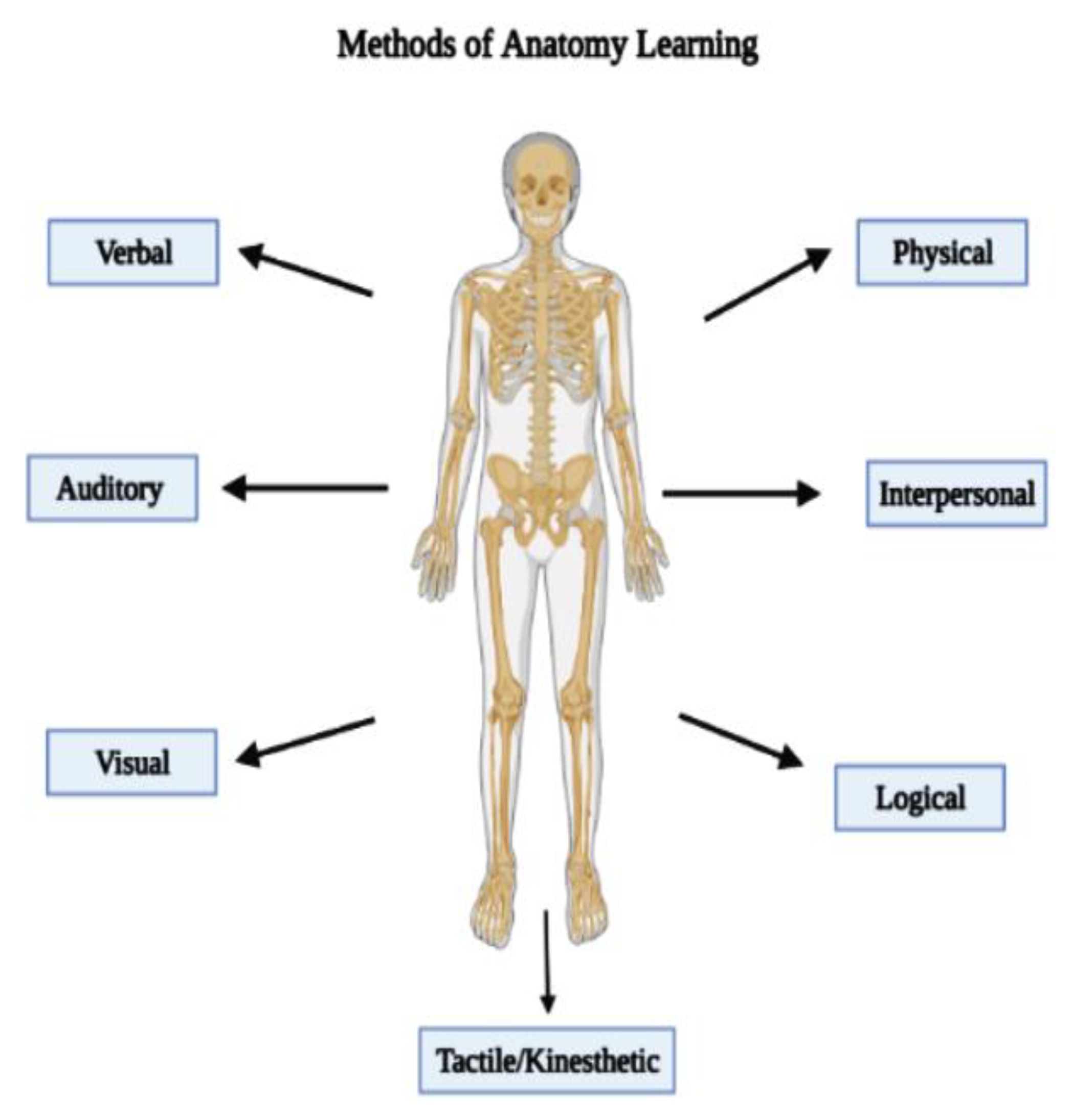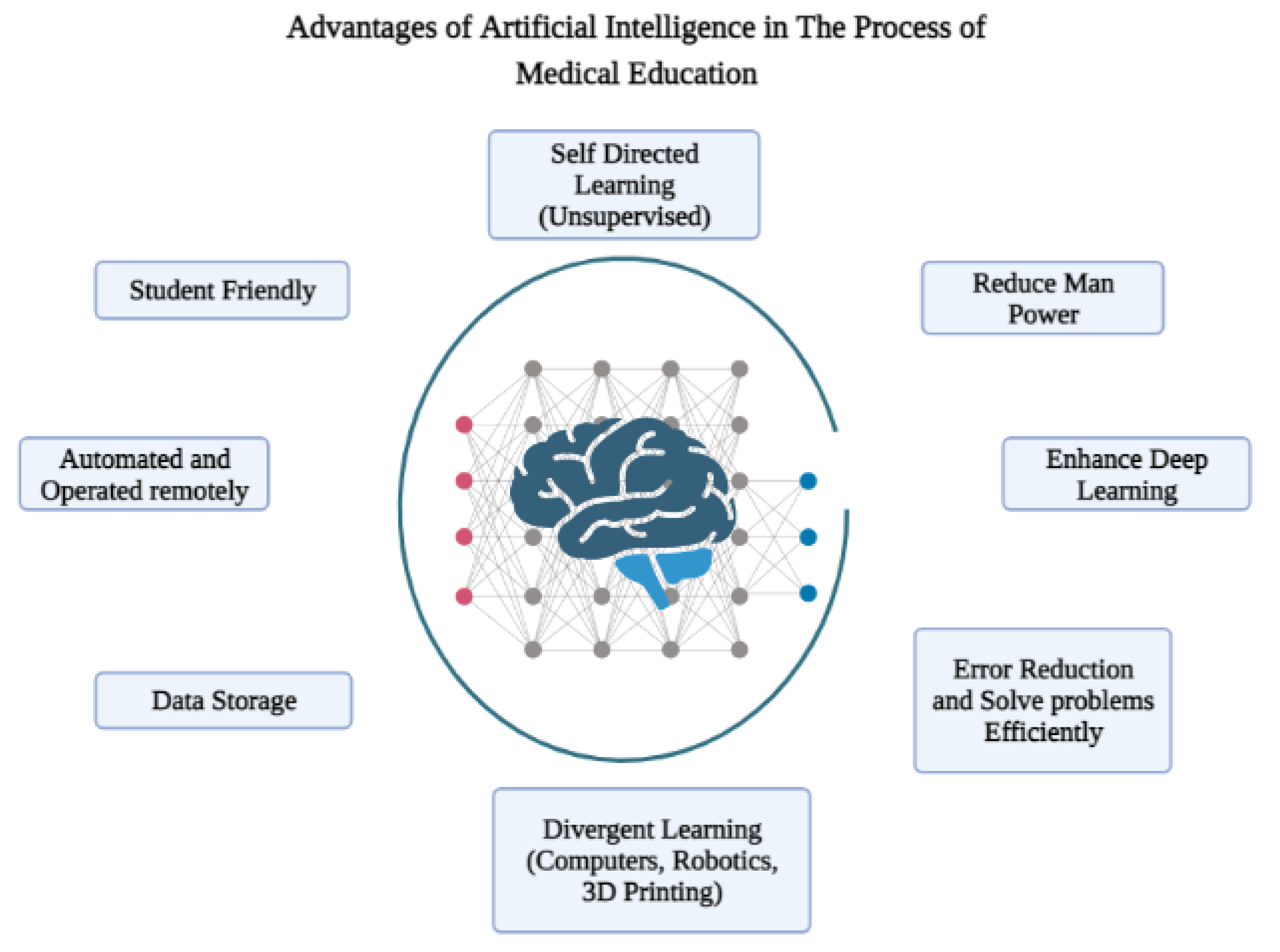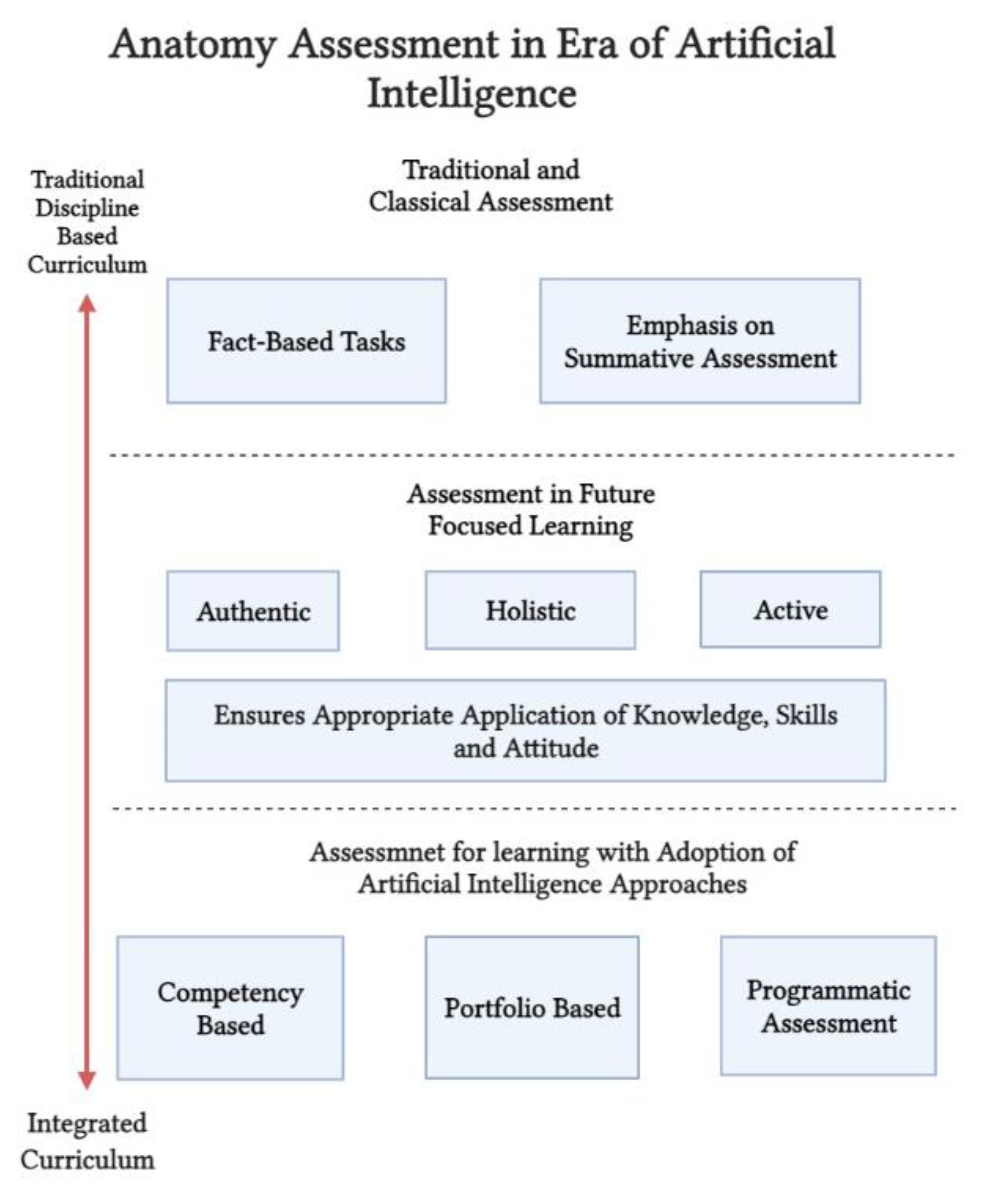Teaching, Learning and Assessing Anatomy with Artificial Intelligence: The Road to a Better Future
Abstract
1. Introduction
1.1. Anatomy in the Medical Profession
1.2. Anatomy Teaching Methods in Medical Courses
2. Artificial Intelligence
3. Lessons Learnt during the COVID-19 Pandemic
4. Novel Uses of Artificial Intelligence to Facilitate Anatomy Teaching, Learning and Assessment
5. Future Novel Scope of Artificial Intelligence in Anatomy Education
- (i)
- Virtual reality apps that will give a deeper understanding of complex branches of anatomy such as embryology and neurosciences.
- (ii)
- Analyzing, computing, storing and summarizing complex but related facts on a specific area or a subfield of Anatomy. As an example in embryology, structures that migrate and differentiate in a particular manner across human development timelines or common molecular regulation pathways which regulate their development, complex neural pathways (e.g., the direct and indirect pathways of basal ganglia) in the brain, could be visualized dynamically by a pathway ‘lighting up’ through the central nervous system, etc. The possibilities are endless. This organized information could be easily accessed through an intelligent machine tool. Thus, a complex topic could be simplified by either breaking it into segments, or making it easily accessible as an overview.
- (iii)
- AI machine tools that would ensure deep learning by enhancing visual learning with 3D images or using them in combination with 3D printing, thus creating real, accurate models of complex anatomical structures, which are sometimes difficult to dissect.
- (iv)
- Deep learning tools that would deliver structured demos of complex areas such as head, face and neck Anatomy, hence would be valuable teaching assistants.
- (v)
- AI systems that could be a valuable resource for self-review: by creating various logistic learning programs, e.g., cause–relationship types of multiple choice questions, problem based clinical scenarios for self-testing etc., a student would have access to immediate feedback and self-assessment.
- (vi)
- AI systems that could be used for objective assessment and compilation of statistical data on student scores and grades, as well as comparisons of academic performances across different cohorts and different modes of learning.
- (vii)
- For medical students and allied health science students in various phases of their courses, students could enhance their practical/clinical and diagnostic skills on interactive robots programmed to mimic specific clinical conditions in patients, which could even display responses to any ‘intervention or simulated treatment’ by medical students, thus equipping them to combat real-life crisis situations more efficiently and confidently.
- (viii)
- Using AI-based apps that could generate anatomical images and self-learning exercises in the form of more complex interactive quizzes (e.g., the Kahoot app and how it has evolved) [76]. We depicted in the schematic diagram (Figure 4) how AI can be incorporated and become beneficial for better Anatomy teaching.
6. Conclusions
Author Contributions
Funding
Institutional Review Board Statement
Informed Consent Statement
Data Availability Statement
Conflicts of Interest
References
- Singh, R.; Shane Tubbs, R.; Gupta, K.; Singh, M.; Jones, D.G.; Kumar, R. Is the decline of human anatomy hazardous to medical education/profession?—A review. Surg. Radiol. Anat. SRA 2015, 37, 1257–1265. [Google Scholar] [CrossRef]
- Zampieri, F.; Zanatta, A.; Elmaghawry, M.; Bonati, M.R.; Thiene, G. Origin and development of modern medicine at the University of Padua and the role of the “Serenissima” Republic of Venice. Glob. Cardiol. Sci. Pract. 2013, 2013, 149–162. [Google Scholar] [CrossRef]
- Vesalius, A. De Humani Corporis Fabrica; Oporinus: Basel, Switzerland, 1543. [Google Scholar]
- Pabst, R.; Rothkotter, H.J. Retrospective evaluation of under-graduate medical education by doctors at the end of their residency time in hospitals: Consequences for the anatomical curriculum. Anat. Rec. 1997, 249, 431–434. [Google Scholar] [CrossRef]
- Moxham, B.J.; Plaisant, O. Perception of medical students towards the clinical relevance of anatomy. Clin. Anat. 2007, 20, 560–564. [Google Scholar] [CrossRef]
- Cottam, W.W. Adequacy of medical school gross anatomy education as perceived by certain postgraduate residency programs and anatomy course directors. Clin. Anat. 1999, 12, 55–65. [Google Scholar] [CrossRef]
- Turney, B.W. Anatomy in a modern medical curriculum. Ann. R. Coll. Surg. Engl. 2007, 89, 104–107. [Google Scholar] [CrossRef]
- Wilson, A.B.; Miller, C.H.; Klein, B.A.; Taylor, M.A.; Goodwin, M.; Boyle, E.K.; Brown, K.; Hoppe, C.; Lazarus, M. A meta-analysis of anatomy laboratory pedagogies. Clin. Anat. 2018, 31, 122–133. [Google Scholar] [CrossRef]
- Estai, M.; Bunt, S. Best teaching practices in anatomy education: A critical review. Ann. Anat. 2016, 208, 151–157. [Google Scholar] [CrossRef]
- Qayumi, A.K.; Qayumi, T. Computer-assisted learning: Cyberpatient—A step in the future of surgical education. J. Investig. Surg. 1999, 12, 307–317. [Google Scholar] [CrossRef]
- Primal Pictures. The Leading 3D Anatomy Resource. 2022. Available online: https://www.primalpictures.com/ (accessed on 25 August 2022).
- InteractElsevier. Netter’s 3D Interactive Anatomy. 2022. Available online: https://netter3danatomy.com/ (accessed on 25 August 2022).
- Anatomage Inc. Anatomage Table. 2022. Available online: https://www.anatomage.com/table/ (accessed on 25 August 2022).
- Martín, J.G.; Mora, C.D.; Henche, S.A. Possibilities for the use of anatomage (the anatomical real body-size table) for teaching and learning anatomy with the students. Biomed. J. Sci. Tech. Res. 2018, 4, 4080–4083. [Google Scholar] [CrossRef][Green Version]
- Baratz, G.; Wilson-Delfosse, A.L.; Singelyn, B.M.; Allan, K.C.; Rieth, G.E.; Ratnaparkhi, R.; Jenks, B.P.; Carlton, C.; Freeman, B.K.; Wish-Baratz, S. Evaluating the anatomage table compared to cadaveric dissection as a learning modality for gross anatomy. Med. Sci. Educ. 2019, 29, 499–506. [Google Scholar] [CrossRef] [PubMed]
- McMenamin, P.G.; Quayle, M.R.; McHenry, C.R.; Adams, J.W. The production of anatomical teaching resources using three-dimensional (3D) printing technology. Anat. Sci. Educ. 2014, 7, 479–486. [Google Scholar] [CrossRef] [PubMed]
- Jaksa, L.; Pahr, D.; Kronreif, G.; Lorenz, A. Development of a Multi-Material 3D Printer for Functional Anatomic Models. Int. J. Bioprint. 2021, 7, 420. [Google Scholar] [CrossRef]
- Vatankhah, R.; Emadzadeh, A.; Nekooei, S.; Yousefi, B.T.; Rezaiyan, M.K.; Moonaghi, H.K.; Razavi, M.E. 3D Printed Models for Teaching Orbital Anatomy, Anomalies and Fractures. J. Ophthalmic. Vis. Res. 2021, 16, 611–619. [Google Scholar] [CrossRef]
- Yuan, Z.M.; Zhang, X.D.; Wu, S.W.; Nian, Z.Z.; Liao, J.; Lin, W.; Zhuang, L.M. A simple and convenient 3D printed temporal bone model for drilling simulating surgery. Acta. Otolaryngol. 2021, 142, 19–22. [Google Scholar] [CrossRef] [PubMed]
- Chytas, D.; Johnson, E.O.; Piagkou, M.; Mazarakis, A.; Babis, G.C.; Chronopoulos, E.; Nikolaou, V.S.; Lazaridis, N.; Natsis, K. The role of augmented reality in Anatomical education: An overview. Ann. Anat. 2020, 229, 151463. [Google Scholar] [CrossRef]
- Mendez-Lopez, M.; Juan, M.C.; Molla, R.; Fidalgo, C. Evaluation of an Augmented Reality Application for Learning Neuroanatomy in Psychology. Anat. Sci. Educ. 2021, 15, 535–551. [Google Scholar] [CrossRef]
- Karbasi, Z.; Kalhori, S.R.N. Application and evaluation of virtual technologies for anatomy education to medical students: A review. Med. J. Islam. Repub. Iran. 2020, 3, 163. [Google Scholar] [CrossRef]
- Bölek, K.A.; De Jong, G.; Henssen, D. The effectiveness of the use of augmented reality in anatomy education: A systematic review and meta-analysis. Sci. Rep. 2021, 11, 15292. [Google Scholar] [CrossRef]
- Finn, G.M. Twelve tips for running a successful body painting teaching session. Med. Teach. 2010, 32, 887–890. [Google Scholar] [CrossRef]
- Finn, G.M.; McLachlan, J.C. A qualitative study of student responses to body painting. Anat. Sci. Educ. 2010, 3, 33–38. [Google Scholar] [CrossRef] [PubMed]
- Finn, G.M.; White, P.M.; Abdelbagi, I. The impact of color and role on retention of knowledge: A body painting study within undergraduate medicine. Anat. Sci. Educ. 2011, 4, 311–317. [Google Scholar] [CrossRef] [PubMed]
- Op Den Akker, J.W.; Bohnen, A.; Oudegeest, W.J.; Hillen, B. Giving color to a new curriculum: Bodypaint as a tool in medical education. Clin. Anat. 2002, 15, 356–362. [Google Scholar] [CrossRef] [PubMed]
- Azer, S.A. Learning surface anatomy: Which learning approach is effective in an integrated PBL curriculum? Med. Teach. 2011, 33, 78–80. [Google Scholar] [CrossRef]
- Ghosh, S.K. Cadaveric dissection as an educational tool for anatomical sciences in the 21st century. Anat. Sci. Educ. 2017, 10, 286–299. [Google Scholar] [CrossRef]
- Potu, B.K.; Shwe, W.H.; Jagadeesan, S.; Aung, T.; Cheng, P.S. Scope of Anatomy Teaching in Problem-based Learning (PBL) Sessions of Integrated Medical Curriculum. Int. J. Morphol. 2013, 31, 899–901. [Google Scholar] [CrossRef]
- McCarthy, J.; Minsky, M.L.; Rochester, N.; Shannon, C.E. A Proposal for the Dartmouth Summer Research Project on Artificial Intelligence, August 31, 1955. AI Magazine. 31 December 2016. Available online: https://ojs.aaai.org//index.php/aimagazine/article/view/1904 (accessed on 25 August 2022).
- Chan, K.S.; Zary, N. Applications and Challenges of Implementing Artificial Intelligence in Medical Education: Integrative Review. JMIR Med. Educ. 2019, 5, e13930. [Google Scholar] [CrossRef]
- Russell, S.; Norvig, P. Artificial Intelligence: A Modern Approach, 3rd ed.; Pearson Education Limited: Harlow, UK, 2010; Available online: https://zoo.cs.yale.edu/classes/cs470/materials/aima2010.pdf (accessed on 25 August 2022).
- Savage, T.R. Artificial Intelligece in Medical Education. Acad. Med. 2021, 96, 1229–1230. [Google Scholar] [CrossRef]
- Bayne, S. Teacherbot: Interventions in automated teaching. Teach. High. Educ. 2015, 20, 455–467. [Google Scholar] [CrossRef]
- Botrel, L.; Holz, E.; Kübler, A. Brain Painting V2: Evaluation of P300-based brain-computer interface for creative expression by an end-user following the user-centered design. Brain-Comput. Interfaces 2015, 2, 135–149. [Google Scholar] [CrossRef]
- Sousa, M.J.; Mas, F.D.; Pesqueira, A.; Lemos, C.; Verde, J.M.; Cobianchi, L. The Potential of AI in Health Higher Education to Increase the Students’ Learning Outcomes. TEM J. 2021, 10, 488–497. [Google Scholar] [CrossRef]
- Emanuel, E.J. The Inevitable Reimagining of Medical Education. JAMA 2020, 323, 1127–1128. [Google Scholar] [CrossRef] [PubMed]
- Pantelimon, F.-V.; Bologa, R.; Toma, A.; Posedaru, B.-S. The Evolution of AI-Driven Educational Systems during the COVID-19 Pandemic. Sustainability 2021, 13, 13501. [Google Scholar] [CrossRef]
- Shaikh, A.A.; Kumar, A.; Jani, K.; Mitra, S.; García-Tadeo, D.A.; Devarajan, A. The Role of Machine Learning and Artificial Intelligence for making a Digital Classroom and its sustainable Impact on Education during COVID-19. Mater. Today Proc. 2022, 56, 3211–3215. [Google Scholar] [CrossRef]
- Holmes, W.; Bialik, M.; Fadel, C. Artificial intelligence in education: Promises and Implications for Teaching and Learning. Boston Cent. Curric. Redes. 2019, 14, 251–259. [Google Scholar]
- Goh, P.S. The vision of transformation in medical education after the COVID-19 pandemic. Korean J. Med. Educ. 2021, 33, 171–174. [Google Scholar] [CrossRef]
- Torda, A. How COVID-19 has pushed us into a medical education revolution. Intern. Med. J. 2020, 50, 1153–1154. [Google Scholar] [CrossRef]
- Kalthur, S.G.; Pandey, A.K.; Prabhath, S. Benefits and pitfalls of learning anatomy using the dissection module in an Indian medical school: A millennial learner’s perspective. Transl. Res. Anat. 2022, 26, 100159. [Google Scholar] [CrossRef]
- Ramesh, A.N.; Kambhampati, C.; Monson, J.R.; Drew, P.J. Artificial intelligence in medicine. Ann. R. Coll. Surg. Engl. 2004, 86, 334–338. [Google Scholar] [CrossRef]
- Richardson, M.L.; Garwood, E.R.; Lee, Y.; Li, M.D.; Lo, H.S.; Nagaraju, A.; Nguyen, X.V.; Probyn, L.; Rajiah, P.; Sin, J.; et al. Noninterpretive Uses of Artificial Intelligence in Radiology. Acad. Radiol. 2021, 28, 1225–1235. [Google Scholar] [CrossRef]
- Nara Institute of Science and Technology. Artificial Intelligence Learns Muscle Anatomy in CT Images. Science Daily. 31 October 2019. Available online: www.sciencedaily.com/releases/2019/10/191031100526.htm (accessed on 25 August 2022).
- Li, Y.S.; Lam, C.S.N.; See, C. Using a Machine Learning Architecture to Create an AI-Powered Chatbot for Anatomy Education. Med. Sci. Educ. 2021, 31, 1729–1730. [Google Scholar] [CrossRef]
- Chan, L.K.; Wiseman, J. Use of the one-minute preceptor as a teaching tool in the gross anatomy laboratory. Anat. Sci. Educ. 2011, 4, 235–238. [Google Scholar] [CrossRef]
- Papa, V.; Varotto, E.; Vaccarezza, M.; Ballestriero, R.; Tafuri, D.; Galassi, F.M. The teaching of anatomy throughout the centuries: From Herophilus to plastination and beyond. Med. Hist. 2019, 3, 69–77. [Google Scholar]
- Sugand, K.; Abrahams, P.; Khurana, A. The anatomy of anatomy: A review for its modernization. Anat. Sci. Educ. 2010, 3, 83–93. [Google Scholar] [CrossRef]
- McBride, J.M.; Drake, R.L. National survey on anatomical sciences in medical education. Anat. Sci. Educ. 2018, 11, 7–14. [Google Scholar] [CrossRef]
- Heylings, D.J. Anatomy 1999–2000: The curriculum, who teaches it and how? Med. Educ. 2002, 36, 702–710. [Google Scholar] [CrossRef]
- Evans, D.J.; Watt, D.J. Provision of anatomical teaching in a new British medical school: Getting the right mix. Anat. Rec. 2005, 284, 22–27. [Google Scholar] [CrossRef]
- Drake, R.L.; McBride, J.M.; Lachman, N.; Pawlina, W. Medical education in the anatomical sciences: The winds of change continue to blow. Anat. Sci. Educ. 2009, 2, 253–259. [Google Scholar] [CrossRef]
- Gregory, J.K.; Lachman, N.; Camp, C.L.; Chen, L.P.; Pawlina, W. Restructuring a basic science course for core competencies: An example from anatomy teaching. Med. Teach. 2009, 31, 855–861. [Google Scholar] [CrossRef]
- Craig, S.; Tait, N.; Boers, D.; McAndrew, D. Review of anatomy education in Australian and New Zealand medical schools. ANZ J. Surg. 2010, 80, 212–216. [Google Scholar] [CrossRef]
- Rizzolo, L.J.; Rando, W.C.; O’Brien, M.K.; Haims, A.H.; Abrahams, J.J.; Stewart, W.B. Design, implementation, and evaluation of an innovative anatomy course. Anat. Sci. Educ. 2010, 3, 109–120. [Google Scholar] [CrossRef] [PubMed]
- Irby, D.M.; Cooke, M.; O’Brien, B.C. Calls for reform of medical education by the Carnegie Foundation for the Advancement of Teaching: 1910 and 2010. Acad. Med. 2010, 85, 220–227. [Google Scholar] [CrossRef] [PubMed]
- Guimarães, B.; Dourado, L.; Tsisar, S.; Diniz, J.M.; Madeira, M.D.; Ferreira, M.A. Rethinking anatomy: How to overcome challenges of medical education’s evolution. Acta. Med. Port. 2017, 30, 134–140. [Google Scholar] [CrossRef] [PubMed]
- Rockarts, J.; Brewer-Deluce, D.; Shali, A.; Mohialdin, V.; Wainman, B. National survey on Canadian undergraduate medical programs: The decline of the anatomical sciences in Canadian medical education. Anat. Sci. Educ. 2020, 13, 381–389. [Google Scholar] [CrossRef] [PubMed]
- Evans, D.J.; Bay, B.H.; Wilson, T.D.; Smith, C.F.; Lachman, N.; Pawlina, W. Going virtual to support anatomy education: A STOPGAP in the midst of the Covid-19 pandemic. Anat. Sci. Educ. 2020, 13, 279–283. [Google Scholar] [CrossRef]
- Pather, N.; Blyth, P.; Chapman, J.A.; Dayal, M.R.; Flack, N.A.; Fogg, Q.A.; Green, R.A.; Hulme, A.K.; Johnson, I.P.; Meyer, A.J.; et al. Forced disruption of anatomy education in Australia and New Zealand: An acute response to the Covid-19 pandemic. Anat. Sci. Educ. 2020, 13, 284–300. [Google Scholar] [CrossRef]
- Longhurst, G.J.; Stone, D.M.; Dulohery, K.; Scully, D.; Campbell, T.; Smith, C.F. Strength, weakness, opportunity, threat (SWOT) analysis of the adaptations to anatomical education in the United Kingdom and Republic of Ireland in response to the COVID-19 pandemic. Anat. Sci. Educ. 2020, 13, 301–311. [Google Scholar] [CrossRef]
- Smith, C.F.; Pawlina, W. A journey like no other: Anatomy 2020! Anat. Sci. Educ. 2021, 14, 5–7. [Google Scholar] [CrossRef]
- PricewaterhouseCoopers (PwC). What Doctor? Why AI and Robotics Will Define New Health, 1st ed.; PricewaterhouseCoopers (PwC): London, UK, 2017; 50p, Available online: https://www.pwc.com/gx/en/industries/healthcare/publications/ai-robotics-newhealth/airobotics-new-health.pdf (accessed on 25 August 2022).
- Roxburgh, M.; Evans, D.J. Assessing Anatomy Education: A Perspective from Design. Anat. Sci. Educ. 2021, 14, 277–286. [Google Scholar] [CrossRef]
- Klenowski, V. Assessment for learning revisited: An Asia-Pacific perspective. Assess. Educ. Princ. Pol. Pract. 2009, 16, 263–268. [Google Scholar] [CrossRef]
- Dannefer, E.F. Beyond assessment of learning toward assessment for learning: Educating tomorrow’s physicians. Med. Teach. 2013, 35, 560–563. [Google Scholar] [CrossRef] [PubMed]
- Hift, R.J. Should essays and other “open-ended”-type questions retain a place in written summative assessment in clinical medicine? BMC Med. Educ. 2014, 14, 249. [Google Scholar] [CrossRef] [PubMed]
- Choudhury, B.; Freemont, A. Assessment of anatomical knowledge: Approaches taken by higher education institutions. Clin. Anat. 2017, 30, 290–299. [Google Scholar] [CrossRef] [PubMed]
- Samarasekera, D.D.; Ang, E.T.; Gwee, M.C. Assessing anatomy as a basic medical science. In Teaching Anatomy: A Practical Guide, 2nd ed.; Chan, L.K., Pawlina, W., Eds.; Springer Nature Switzerland AG: Cham, Switzerland, 2020; pp. 393–404. [Google Scholar]
- Schwab, K. The Fourth Industrial Revolution, 1st ed.; Crown Business: New York, NY, USA, 2016; p. 192. [Google Scholar]
- Yu, K.H.; Beam, A.L.; Kohane, I.S. Artificial intelligence in healthcare. Nat. Biomed. Eng. 2018, 2, 719–731. [Google Scholar] [CrossRef] [PubMed]
- Han, E.R.; Yeo, S.; Kim, M.J.; Lee, Y.H.; Park, K.H.; Roh, H. Medical education trends for future physicians in the era of advanced technology and artificial intelligence: An integrative review. BMC Med. Educ. 2019, 19, 460. [Google Scholar] [CrossRef] [PubMed]
- Ismail, M.A.; Ahmad, A.; Mohammad, J.A.; Fakri, N.M.R.M.; Nor, M.Z.M.; Pa, M.N.M. Using Kahoot! as a formative assessment tool in medical education: A phenomenological study. BMC Med. Educ. 2019, 19, 230. [Google Scholar] [CrossRef]
- Lazarus, M.D.; Truong, M.; Douglas, P.; Selwyn, N. Artificial intelligence and clinical anatomical education: Promises and perils. Anat. Sci. Educ. 2022. ahead of print. [Google Scholar] [CrossRef]
- Lindqwister, A.L.; Hassanpour, S.; Lewis, P.J.; Sin, J.M. AI-RADS: An Artificial Intelligence Curriculum for Residents. Acad. Radiol. 2021, 28, 1810–1816. [Google Scholar] [CrossRef]
- Banerjee, A.; Chakraborty, C.; Kumar, A.; Biswas, D. Emerging trends in IoT and big data analytics for biomedical and health care technologies. In Handbook of Data Science Approaches for Biomedical Engineering, 1st ed.; Balas, V.E., Solanki, V.K., Kumar, R., Khari, M., Eds.; Academic Press: London, UK, 2020; pp. 121–152. [Google Scholar]




Publisher’s Note: MDPI stays neutral with regard to jurisdictional claims in published maps and institutional affiliations. |
© 2022 by the authors. Licensee MDPI, Basel, Switzerland. This article is an open access article distributed under the terms and conditions of the Creative Commons Attribution (CC BY) license (https://creativecommons.org/licenses/by/4.0/).
Share and Cite
Abdellatif, H.; Al Mushaiqri, M.; Albalushi, H.; Al-Zaabi, A.A.; Roychoudhury, S.; Das, S. Teaching, Learning and Assessing Anatomy with Artificial Intelligence: The Road to a Better Future. Int. J. Environ. Res. Public Health 2022, 19, 14209. https://doi.org/10.3390/ijerph192114209
Abdellatif H, Al Mushaiqri M, Albalushi H, Al-Zaabi AA, Roychoudhury S, Das S. Teaching, Learning and Assessing Anatomy with Artificial Intelligence: The Road to a Better Future. International Journal of Environmental Research and Public Health. 2022; 19(21):14209. https://doi.org/10.3390/ijerph192114209
Chicago/Turabian StyleAbdellatif, Hussein, Mohamed Al Mushaiqri, Halima Albalushi, Adhari Abdullah Al-Zaabi, Sadhana Roychoudhury, and Srijit Das. 2022. "Teaching, Learning and Assessing Anatomy with Artificial Intelligence: The Road to a Better Future" International Journal of Environmental Research and Public Health 19, no. 21: 14209. https://doi.org/10.3390/ijerph192114209
APA StyleAbdellatif, H., Al Mushaiqri, M., Albalushi, H., Al-Zaabi, A. A., Roychoudhury, S., & Das, S. (2022). Teaching, Learning and Assessing Anatomy with Artificial Intelligence: The Road to a Better Future. International Journal of Environmental Research and Public Health, 19(21), 14209. https://doi.org/10.3390/ijerph192114209






